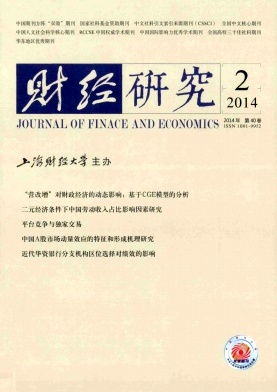激励性规制对中国电信业全要素生产率的影响——基于省际动态面板数据的实证研究
财经研究 2014 年 第 40 卷第 02 期, 页码:85 - 96
摘要
参考文献
摘要
基于中国电信业规制改革的渐进性特征,文章建立省际动态面板数据模型,运用系统GMM估计方法,实证检验了价格上限规制、混合价格规制和固定利润分享规制等多种激励性规制与电信业全要素生产率的关系。研究结果表明:当期和滞后一期混合价格规制对电信业生产率的影响都不大;价格上限规制对行业生产率增长具有一定的推动作用,但总体影响较小;固定利润分享规制对电信业生产率增长的同期促进作用显著,但滞后效应的消极影响较大。据此,文章提出完善价格上限规制的制度设计、增强规制机构的独立性和加强规制司法审查等政策建议。
[1]常硕,崔静宜.中国电信业效率测评及影响因素分析[J].产经评论,2011,(5):34-40.
[2]初佳颖.中国电信产业的激励规制绩效分析[D].山东大学博士论文,2006.
[3]李再扬,杨少华.中国省级电信业技术效率:区域差异及影响因素[J].中国工业经济,2010,(8):129-139.
[4]汪贵浦,陈明亮.邮电通信业市场势力测度及对行业发展影响的实证分析[J].中国工业经济,2007,(1):21-28.
[5]汪伟.中国居民储蓄率的决定因素——基于1995-2005年省际动态面板数据的分析[J].财经研究,2008,(2):53-64.
[6]杨少华,李再扬.中国电信业生产率变动及其分解:基于DEA-Malmquist指数法的分析[J].经济学家,2010,(10):64-71.
[7]张东辉,初佳颖.中国电信产业的规制效率分析[J].财经问题研究,2008,(4):52-55.
[8]郑世林.市场竞争还是产权改革提高了电信业绩效[J].世界经济,2010,(6):118-139.
[9]郑世林,张昕竹.经济体制改革与中国电信行业增长:1994-2007[J].经济研究,2011,(10):67-80.
[10]Averch H,Johnson L L.Behavior of the firm under regulatory constraint[J].American Economic Review,1962,52(5):1052-1069.
[11]Blundell R,Bond S.Initial conditions and moment restrictions in dynamic panel data models[J].Journal of econometrics,1998,87(1):115-143.
[12]Bortolotti B D,Souza J,Fantini M.Privatization and the sources of performance improvement in the global telecommunications industry[J].Telecommunications Policy,2002,26(5-6):243-268.
[13]Braeutigam R R,Panzar J C.Effects of the change from rate-of-return to price-cap regulation[J].American:Economic Review,1993,83(2):191-198.
[14]Burns P,Ralph T,Thomas G W.The behaviour of the firm under alternative regulatory constraints[J].Scottish Journal of Political Economy,1998,45(2):133-157.
[15]Calabrese A,Campisi D,Mancuso P.Productivity change in the telecommunications industries of 13OECD countries[J].International Journal of Business and Economics,2002,1(3):209-223.
[16]Caves D W,Christensen L R,Diewert W E.The economic theory of index numbers and the measurement of input,output,and productivity[J].Econometrica,1982,50(6):1393-1414.
[17]Fare R,Grosskopf S,Lovell C K.Multilateral productivity comparisons when some outputs are undesirable:A nonparametric approach[J].The Review of Economics and Statistics,1989,71(1):90-98.
[18]Fare R,Grosskopf S,Norris M.Productivity growth,technical progress,and efficiency change in industrialized countries[J].The American Economic Review,1994,84(1):66-83.
[19]Farrell M J.The Measurement of productive efficiency[J].Journal of the Royal Statistical Society.Series A(General),1957,120(3):253-290.
[20]Greene W H.Econometric analysis(6th ed.)[M].New Jersey:Pearson Prentice Hall,2007.
[21]Gutiérrez L H.The effect of endogenous regulation on telecommunications expansion and efficiency in Latin America[J].Journal of Regulatory Economics,2003,23(3):257-286.
[22]Joskow P L.Incentive regulation in theory and practice:Electricity distribution and transmission networks[A].Nancy L Rose.Economic regulation and its reform:What have we learned?[C].Chicago:University of Chicago Press,2005.
[23]Lam P,Shiu A.Productivity analysis of the telecommunications sector in China[J].Telecommunications Policy,2008,32(8):559-571.
[24]Leibenstein H.Allocative efficiency vs.“X-efficiency”[J].American Economic Review,1966,56(3):392-415.
[25]Majumdar S K.Incentive regulation and productive efficiency in the US telecommunications industry[J].The Journal of Business,1997,70(4):547-576.
[26]Resende M.Productivity growth and regulation in US local telephony[J].Information Economics and Policy,1999,11(1):23-44.
[27]Roodman D.How to do xtabond2:An introduction to“Difference”and“System”GMM in Stata[J].Stata Journal,2009,9(1):86-136.
[28]Seo D,Shin J.The impact of incentive regulation on productivity in the US telecommunications industry:A stochastic frontier approach[J].Information Economics and Policy,2011,23(1):3-11.
[29]Shephard R W,Gale D,Kuhn H W.Theory of cost and production functions[M].Princeton:Princeton University Press,1970.
[30]Sappington D E M,Weisman D L.Potential pitfalls in empirical investigations of the effects of incentive regulation plans in the telecommunications industry[J].Information Economics and Policy,1996,8(2):125-140.
[31]Sueyoshi T.Privatization of nippon telegraph and telephone:Was it a good policy decision?[J].European Journal of Operational Research,1998,107(1):45-61.
[32]Uri N D.Measuring the change in productive efficiency in telecommunications in the USA[J].Journal of Economic Studies,2002,29(2):150-167.
[33]Uri N D.Productivity change,technical progress,and efficiency improvement in telecommunications[J].Review of Industrial Organization,2001,18(3):283-300.
[34]Yoon C.Liberalisation policy,industry structure and productivity changes in Korea’s telecommunications industry[J].Telecommunications Policy,1999,23(3-4):289-306.
①收益率规制是指通过限制企业资本回报率的办法使得企业的资本获得公正的回报。2000年颁布的《中华人民共和国电信条例》确定了电信资费标准实行以成本为基础的定价原则(收益率规制),2005年之前,电信基础业务价格规制基本上都属于收益率规制。长期以来,收益率规制的激励作用受到经济学家的大量批评。Averch和Johnson(1962)认为收益率规制会产生A-J效应,即收益率规制不能最小化产出成本且导致过度的资本投资。张东辉和初佳颖(2008)以1999-2004年中国电信行业数据分析发现,收益率规制并没有提高行业效率。
②价格上限规制是指对被规制企业的产品或服务的价格设置一个上限,不允许企业定价超过规定的上限的一种规制方法。英国提出的价格上限应遵守RPI-X规则,其中RPI=零售价格指数,X是预期的行业生产率增长率。
③利润分享规制是指在一定的收益范围内,被规制企业得到所有的收益,超额收益或亏损超过初期设置的范围将与纳税人分享(Sappington和Weisman,1996)。
④2009年11月对固定本地电话等电信业务也开始实行价格上限规制。
⑤自1994年分税制改革以来,大多数国有企业的利润都不用上缴国家,造成了企业的留存利润规模逐步扩大,2006年国有企业税后利润达到6 252亿元(数据来源:http://news.enorth.com.cn/system/2007/09/14/001974064.shtml),国有企业效益有了较大提升,总体上走出了困境。2007年经国务院批准,财政部、国资委于12月17日印发了《中央企业国有资本收益收取管理暂行办法》,管理办法规定电信等国有垄断行业的企业要以归属于其母公司所有者的净利润为基数上缴红利,上缴红利的比例为10%。2007年12月20日对电信企业2006年实现的国有资本收益进行收取。可见,我国电信业的利润分享方法不同于国外的利润分享规制(Sappington和Weisman,1996),我国采用的利润分享比例是固定的,它不随企业利润水平的变化而变化,因此,本文将这种利润分享规制方式称为固定利润分享规制。从2007年开始,我国电信业实行固定利润分享规制。
⑥本文投入指标与Lam和shiu(2008)、郑世林和张昕竹(2011)、常硕和崔静宜(2012)的一致。
⑦三大区域的划分标准来自于2010年《中国通信统计年度报告》。
[2]初佳颖.中国电信产业的激励规制绩效分析[D].山东大学博士论文,2006.
[3]李再扬,杨少华.中国省级电信业技术效率:区域差异及影响因素[J].中国工业经济,2010,(8):129-139.
[4]汪贵浦,陈明亮.邮电通信业市场势力测度及对行业发展影响的实证分析[J].中国工业经济,2007,(1):21-28.
[5]汪伟.中国居民储蓄率的决定因素——基于1995-2005年省际动态面板数据的分析[J].财经研究,2008,(2):53-64.
[6]杨少华,李再扬.中国电信业生产率变动及其分解:基于DEA-Malmquist指数法的分析[J].经济学家,2010,(10):64-71.
[7]张东辉,初佳颖.中国电信产业的规制效率分析[J].财经问题研究,2008,(4):52-55.
[8]郑世林.市场竞争还是产权改革提高了电信业绩效[J].世界经济,2010,(6):118-139.
[9]郑世林,张昕竹.经济体制改革与中国电信行业增长:1994-2007[J].经济研究,2011,(10):67-80.
[10]Averch H,Johnson L L.Behavior of the firm under regulatory constraint[J].American Economic Review,1962,52(5):1052-1069.
[11]Blundell R,Bond S.Initial conditions and moment restrictions in dynamic panel data models[J].Journal of econometrics,1998,87(1):115-143.
[12]Bortolotti B D,Souza J,Fantini M.Privatization and the sources of performance improvement in the global telecommunications industry[J].Telecommunications Policy,2002,26(5-6):243-268.
[13]Braeutigam R R,Panzar J C.Effects of the change from rate-of-return to price-cap regulation[J].American:Economic Review,1993,83(2):191-198.
[14]Burns P,Ralph T,Thomas G W.The behaviour of the firm under alternative regulatory constraints[J].Scottish Journal of Political Economy,1998,45(2):133-157.
[15]Calabrese A,Campisi D,Mancuso P.Productivity change in the telecommunications industries of 13OECD countries[J].International Journal of Business and Economics,2002,1(3):209-223.
[16]Caves D W,Christensen L R,Diewert W E.The economic theory of index numbers and the measurement of input,output,and productivity[J].Econometrica,1982,50(6):1393-1414.
[17]Fare R,Grosskopf S,Lovell C K.Multilateral productivity comparisons when some outputs are undesirable:A nonparametric approach[J].The Review of Economics and Statistics,1989,71(1):90-98.
[18]Fare R,Grosskopf S,Norris M.Productivity growth,technical progress,and efficiency change in industrialized countries[J].The American Economic Review,1994,84(1):66-83.
[19]Farrell M J.The Measurement of productive efficiency[J].Journal of the Royal Statistical Society.Series A(General),1957,120(3):253-290.
[20]Greene W H.Econometric analysis(6th ed.)[M].New Jersey:Pearson Prentice Hall,2007.
[21]Gutiérrez L H.The effect of endogenous regulation on telecommunications expansion and efficiency in Latin America[J].Journal of Regulatory Economics,2003,23(3):257-286.
[22]Joskow P L.Incentive regulation in theory and practice:Electricity distribution and transmission networks[A].Nancy L Rose.Economic regulation and its reform:What have we learned?[C].Chicago:University of Chicago Press,2005.
[23]Lam P,Shiu A.Productivity analysis of the telecommunications sector in China[J].Telecommunications Policy,2008,32(8):559-571.
[24]Leibenstein H.Allocative efficiency vs.“X-efficiency”[J].American Economic Review,1966,56(3):392-415.
[25]Majumdar S K.Incentive regulation and productive efficiency in the US telecommunications industry[J].The Journal of Business,1997,70(4):547-576.
[26]Resende M.Productivity growth and regulation in US local telephony[J].Information Economics and Policy,1999,11(1):23-44.
[27]Roodman D.How to do xtabond2:An introduction to“Difference”and“System”GMM in Stata[J].Stata Journal,2009,9(1):86-136.
[28]Seo D,Shin J.The impact of incentive regulation on productivity in the US telecommunications industry:A stochastic frontier approach[J].Information Economics and Policy,2011,23(1):3-11.
[29]Shephard R W,Gale D,Kuhn H W.Theory of cost and production functions[M].Princeton:Princeton University Press,1970.
[30]Sappington D E M,Weisman D L.Potential pitfalls in empirical investigations of the effects of incentive regulation plans in the telecommunications industry[J].Information Economics and Policy,1996,8(2):125-140.
[31]Sueyoshi T.Privatization of nippon telegraph and telephone:Was it a good policy decision?[J].European Journal of Operational Research,1998,107(1):45-61.
[32]Uri N D.Measuring the change in productive efficiency in telecommunications in the USA[J].Journal of Economic Studies,2002,29(2):150-167.
[33]Uri N D.Productivity change,technical progress,and efficiency improvement in telecommunications[J].Review of Industrial Organization,2001,18(3):283-300.
[34]Yoon C.Liberalisation policy,industry structure and productivity changes in Korea’s telecommunications industry[J].Telecommunications Policy,1999,23(3-4):289-306.
①收益率规制是指通过限制企业资本回报率的办法使得企业的资本获得公正的回报。2000年颁布的《中华人民共和国电信条例》确定了电信资费标准实行以成本为基础的定价原则(收益率规制),2005年之前,电信基础业务价格规制基本上都属于收益率规制。长期以来,收益率规制的激励作用受到经济学家的大量批评。Averch和Johnson(1962)认为收益率规制会产生A-J效应,即收益率规制不能最小化产出成本且导致过度的资本投资。张东辉和初佳颖(2008)以1999-2004年中国电信行业数据分析发现,收益率规制并没有提高行业效率。
②价格上限规制是指对被规制企业的产品或服务的价格设置一个上限,不允许企业定价超过规定的上限的一种规制方法。英国提出的价格上限应遵守RPI-X规则,其中RPI=零售价格指数,X是预期的行业生产率增长率。
③利润分享规制是指在一定的收益范围内,被规制企业得到所有的收益,超额收益或亏损超过初期设置的范围将与纳税人分享(Sappington和Weisman,1996)。
④2009年11月对固定本地电话等电信业务也开始实行价格上限规制。
⑤自1994年分税制改革以来,大多数国有企业的利润都不用上缴国家,造成了企业的留存利润规模逐步扩大,2006年国有企业税后利润达到6 252亿元(数据来源:http://news.enorth.com.cn/system/2007/09/14/001974064.shtml),国有企业效益有了较大提升,总体上走出了困境。2007年经国务院批准,财政部、国资委于12月17日印发了《中央企业国有资本收益收取管理暂行办法》,管理办法规定电信等国有垄断行业的企业要以归属于其母公司所有者的净利润为基数上缴红利,上缴红利的比例为10%。2007年12月20日对电信企业2006年实现的国有资本收益进行收取。可见,我国电信业的利润分享方法不同于国外的利润分享规制(Sappington和Weisman,1996),我国采用的利润分享比例是固定的,它不随企业利润水平的变化而变化,因此,本文将这种利润分享规制方式称为固定利润分享规制。从2007年开始,我国电信业实行固定利润分享规制。
⑥本文投入指标与Lam和shiu(2008)、郑世林和张昕竹(2011)、常硕和崔静宜(2012)的一致。
⑦三大区域的划分标准来自于2010年《中国通信统计年度报告》。
引用本文
郑加梅, 夏大慰. 激励性规制对中国电信业全要素生产率的影响——基于省际动态面板数据的实证研究[J]. 财经研究, 2014, 40(2): 85–96.
导出参考文献,格式为:





 7950
7950  4207
4207

